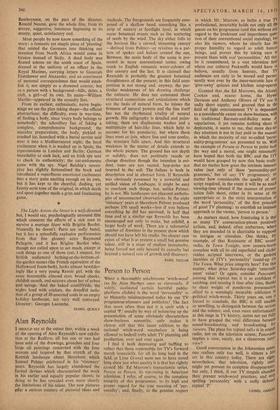Alan Reynolds
I SHOULD say at the outset that, within a week of the opening of Alan Reynolds's new exhibi- tion at the Redfern, all but one or two had been sold of the drawings, gouaches and four 'large oil paintings concerned with the four seasons and inspired by that stretch of the Kentish landscape about Shoreham which Samuel Palmer celebrated in his 'visionary' years. Reynolds has largely abandoned the forthal devices which characterised the work in his earlier and equally popular shows; in doing so he has revealed even more clearly the limitations of his talent. The new pictures offer a curious mixture of pictorial ideas and methods. The foregrounds are frequently corn- posed of a shallow band, something like a strip of scenery at footlight level, in which occur botanical events such as the scattering of seeds by the wind. The sky either falls to the horizon like a curved, streaming canopy —derived from Palmer—or revolves in,a pat- tern of spokes and haloes around the sun. Between, the main body of the scene is pre- sented in more conventional terms, owing much to English romantic water-colours of this century and the last. It is claimed that Reynolds is probably the greatest botanical draughtsman of the present; in this field com- petition is not strong and, anyway, the par- ticular weaknesses of his drawing challenge the estimate. He does not command those structural connections and articulations which are the basis of natural form, he misses the firmness of natural pattern and the line itself has not the rhythmical vitality of natural growth. His calligraphy is detailed and pains- taking; there are diaphanous washes and a multiplicity of hair-like lines, which help to account for his popularity, but where these lines meet or join, where line and tone confer, the structure falls apart. And this structural weakness in the matter of details extends to the whole picture, The ground has not depth or solidity, does not positively recede or change direction though the intention is evi- dent, trees are not rooted. hop-poles not inserted in the soil. The failure is both in description and in abstract form. If Reynolds was obviously possessed by a powerful and unified vision of landscape, it might be easy to overlook such things, but, unlike Palmer, he is not. His landscapes are pleasant antholo- gies of unconnected observations. In the eight 'visionary' years at Shoreham Palmer produced perhaps 150 small works—less if you believe everything he did has survived; in half that time and at a similar age Reynolds has been encouraged not only to make, but exhibif, a larger body of work. There are a substantial number of drawings in the present show which should not have left his studio. No clearer case exists of what is at present a small but genuine talent, still in a stage of student immaturity. being forced not only beyond its capacity but beyond a natural rate of growth and discovery.
BASIL TAYLOR


































 Previous page
Previous page